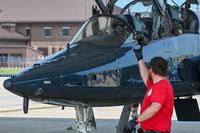Imagine a Navy strike plane launching off the catapult as its carrier begins steaming out of its San Diego naval base. The jet refuels over Hawaii, then again over Guam; it gets updated targeting data from its mother ship 6,000 miles away and launches its strike on an enemy nuclear missile silo in East Asia -- all in one sortie.
Sound impossible?
And, oh, it could turn around and land on another carrier in the Red Sea after taking some surveillance photos of a suspected terrorist training camp in Pakistan and beaming them down to commanders in Bagram.
That's just the half of what a naval unmanned combat drone could potentially do, says a new report from a respected Washington, D.C.-based defense think tank. Why land on the carrier in the Red Sea? Why not tank over the Med, fly up to the Arctic and beam back radio transmissions from an ongoing Russian war game, then fly back to its mother carrier now a few hundred miles from its home port?
These experts say unrefueled ranges of 1,500 miles and 100 hour endurance could be the norm with so-called unmanned combat air systems now being developed.
"Because of its great range, persistence, and stealth, [a naval combat drone] would be able to perform missions beyond the capabilities of manned aircraft, and enable US aircraft carriers to perform both their traditional missions better and to undertake completely new missions," write Center for Strategic and Budgetary Assessments Senior Fellow Tom Ehrhard and strategic studies vice president Bob Work in their June 18 report "Range, Persistence, Stealth and Networking: The Case for a Carrier-Based Unmanned Combat Air System."
If fully realized, the N-UCAS could "provide the Navy's future carrier air wings with the organic, extended-range, survivable, and persistent surveillance-strike capability needed to meet a number of emerging 21st century security challenges," including emerging nuclear powers, homeland defense threats and the emerging anti-access strategy from China, the report's authors write.
So why then does the Navy seem to be giving the naval combat drone short shrift? Though the service has continued funding for the $636 million UCAS demonstrator program lead by Northrop Grumman and its X-47B to prove the carrier-based drone capability by 2013, Navy planning documents show the service intends to fold the drone UCAS program into its future strike fighter program to replace the F/A-18E and F-model manned jets.
According to the Navy's "Naval Aviation Plan 2030 Guidance" document obtained by DoD Buzz, "the N-UCAS program will be refocused in POM-10 from a carrier-based penetrating, persistent ISR/Tactical Support Team capability to a 6th-generation strike fighter capability that will recapitalize the F/A-18E/F in 2025," that would be renamed F/A-XX.
In other words, this gives the Navy an opening to kick the UCAS can down the road even further.
"This may make it easier to shift funds from the UCAS-D program in the face of sharp budget pressures over the next several years," Ehrhard and Work write.
For their part, Northrop Grumman isn't letting on to any funding worries -- at least publicly.
"It is difficult to imagine that the program would be [cancelled or delayed] because it represents a great success story for Navy acquisition. And more than $1 billion has been invested in this program after many stops and starts during J-UCAS," a Northrop Grumman program official told DoD Buzz. "The Navy has done an exemplary job in making 'the technology leap' to carrier-based persistent, unmanned reconnaissance and strike platforms."
And they feel like the Navy might be accused of an affliction of "next-war-itis" by a guy who seems not to countenance such maladies for long.
"As evidenced in his public comments, Secretary of Defense Gates fully supports the development and deployment of UAVs, and it is our hope that his views are considered before any action is taken on UCAS-D," the Northrop Grumman official said.








